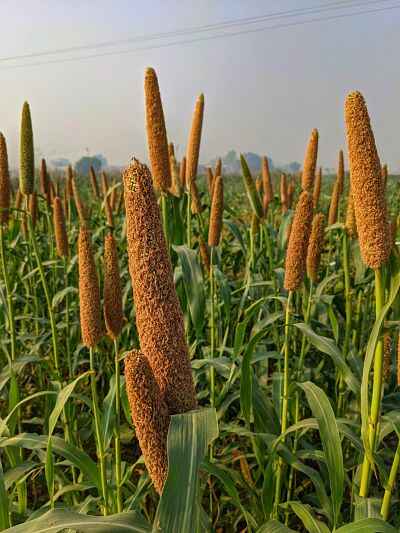Pearl millet (Bajra) is a widely used and widely grown crop as a cereal. Which has been easily grown and used as a food item since ancient times in the Indian subcontinent and the Sahel region of Africa. Apart from humans, it is also used for feed for animals and for fodder in the green state. Therefore, in this post, we have given information about the scientific name or Botanical name and family of Bajra.
Botanical name and family of Bajra
Table of Contents
Name – Bajra (Pearl millet)
Pennisetum glaucum
Family of Bajra – Grass family (Poaceae or Gramineae)
Origin of Bajra – India or Africa.

Chromosome number of bajra – 2n = 2x = 14
It is well known that millets are a storehouse of nutrients. As the name suggests, it is also rich in calories, fiber, protein, fat, minerals (magnesium, potassium, calcium, phosphorus, iron), etc. Since it contains a good amount of fiber, it is digestible as well as keeps the heart healthy.
Health Benefits of Bajra:
- High in fiber and aids digestion:
- Bajra is a good source of dietary fiber, promoting healthy digestion, preventing constipation, and aiding in weight management.
- Helps in managing diabetes:
- Bajra has a low glycemic index, making it an excellent choice for individuals with diabetes. It helps regulate blood sugar levels and improves insulin sensitivity.
- Rich source of iron and other essential minerals:
- Bajra is abundant in iron, calcium, magnesium, and phosphorus. These minerals are essential for maintaining healthy bones, teeth, and blood cell production.
- Boosts immunity and promotes overall health:
- Bajra contains antioxidants and immune-boosting properties that enhance the body’s defense mechanism. It aids in
Cooking with Bajra:
- Different forms of bajra: whole, flour, and flakes:
- Bajra can be consumed in various forms, such as whole grains, flour, and flakes. Each form offers unique culinary possibilities and nutritional benefits.
- How to cook the whole bajra:
- Soak bajra overnight, drain, and cook it with water until tender. Use it as a base for salads, soups, or as a side dish with curries.
- Bajra flour and its uses:
- Bajra flour is a versatile ingredient that can be used in making rotis (flatbreads), pancakes, and even baked goods like bread and cookies.
- Incorporating bajra flakes in recipes:
- Bajra flakes can be used as a nutritious substitute for oats in porridge, as a crunchy topping for salads, or as an ingredient in energy bars.
Delicious Bajra Recipes:
- Bajra Roti (Pearl Millet Flatbread):
- Learn how to make traditional bajra roti, a nutritious and gluten-free flatbread that pairs well with curries and lentils.
- Bajra Khichdi (Pearl Millet Porridge):
- Explore the comforting and wholesome bajra khichdi recipe, a one-pot meal made with pearl millet, lentils, and spices.
- Bajra Methi Puri (Pearl Millet and Fenugreek Puffs):
- Try these crispy and flavorful puris made with a combination of bajra flour, fenugreek leaves, and spices.
- Bajra Upma (Pearl Millet Savory Porridge):
- Enjoy a hearty breakfast with bajra upma, a savory porridge made with pearl millet, vegetables, and aromatic spices.
- Bajra Ladoo (Pearl Millet Energy Balls):
- Indulge in these healthy and energy-boosting ladoos made with bajra flour, nuts, and natural sweeteners.
The nutritional profile of bajra
Bajra, also known as pearl millet, has a rich nutritional profile that makes it a valuable addition to a healthy diet. Here is a breakdown of the key nutrients found in bajra:
- Carbohydrates: Bajra is primarily composed of carbohydrates, providing a good source of energy for the body.
- Dietary Fiber: Bajra is high in dietary fiber, both soluble and insoluble. This fiber aids digestion, promotes bowel regularity, and helps maintain a healthy weight.
- Protein: Bajra contains a moderate amount of protein, making it a suitable choice for vegetarians and vegans looking to meet their protein needs.
- Vitamins: Bajra is a good source of several vitamins, including niacin (vitamin B3), thiamine (vitamin B1), and vitamin B6. These vitamins are important for energy production, brain function, and maintaining overall health.
- Minerals: Bajra is rich in minerals such as iron, calcium, magnesium, and phosphorus. Iron is essential for oxygen transport in the body, while calcium, magnesium, and phosphorus contribute to bone health and proper muscle function.
It’s important to note that the exact nutritional content may vary slightly depending on the variety and preparation of bajra. Nevertheless, incorporating bajra into your diet can provide a range of essential nutrients that contribute to overall health and well-being.
Conclusion:
Incorporating bajra (pearl millet) into your diet can provide numerous health benefits. From its high fiber content to its mineral-rich profile, bajra offers a wide range of culinary possibilities and a flavorful experience. Embrace the goodness of this ancient grain and explore the various recipes to enjoy its nutritional benefits.
Read more:
FAQ.
Pearl millet is the English name of Bajra.
The family of Bajra belongs to the Grass family, but it is also known as Poaceae or Gramineae.
‘Sajje’, ‘Kambu’, ‘Bajeer’, ‘Gero’, “pearl millet”, Bajree, Spiked Millet, bulrush millet, babala, etc are the other common name of Bajra.
Pennisetum glaucum
To know more about Bajra, you can go to the link Wikipedia.